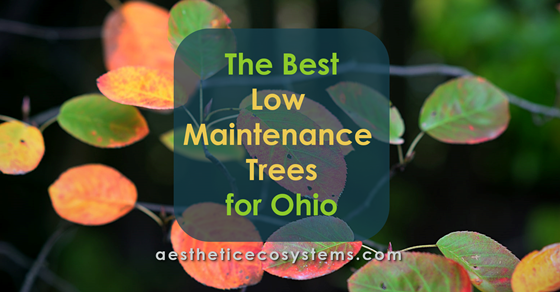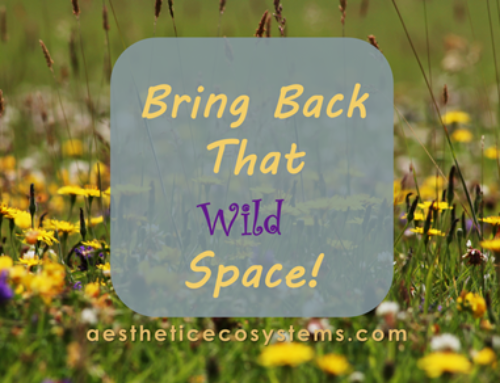If you live in or close to Ohio, this article is a must read for your tree planting ideas.
Get the expert opinion of low maintenance landscape designers from across Ohio on the top low maintenance trees they use in their designs for front yard landscaping.
Below is a list of easy landscape trees for Ohio, followed by the contact information of these designers.
If you’re looking for front yard design ideas to create a beautiful healthy landscape without tons of yard work, reach out to them for some awesome design help!
When you’re looking to save time on yard work, the right plants in the right place can really make a difference. When considering plants for your landscape, it is important to consider the growing conditions of your specific garden location, as well as the aesthetics and form of your intended planting.
Important considerations for easy perennial plants and low maintenance landscapes:
- Know your soil type
- Get a soil test!
- Know your pH
- Know your soil texture (sand, loam, silt, clay)
- Select plants adapted to:
- Your soil type
- The water availability in your garden
- The fertility level of your site
- Other nearby plants
- Consider aesthetics
- Right plant form
- Proper plant groupings
- Consider plant growth
- Seed dispersal
- Growing habit
- Spreading habit
Once you’ve considered the right conditions for your plants, here are some awesome suggestions on what to plant!
Each of the trees and shrubs listed below were recommended by two or more designers to be included.
Most of these plants are easy perennial plants native to this region and bring a lot of beauty and texture to your landscape. Some are short-lived perennials or self-reseeding annuals that can reseed to come back each year. Some are non-native exotics that are well adapted to the growing conditions of Ohio without spreading profusely in the wild.
Also be sure to check out the other sister articles to this one:
Get a free copy of all plants in one easy to navigate file!
Evergreens
Evergreens are prized for their year-round foliage. Consider the following for your evergreen tree planting needs. There are two specific native plant groups that are commonly used in low maintenance front yard landscaping: Juniper and Arborvitae.
- Juniper
- The Juniper genus is widely spread all across the world throughout the northern hemisphere. This evergreen varies from low growing shrubs to medium sized evergreen trees. They provide year-round cover to many native birds and have fine textured foliage to bring year-round interest to your garden.
- Key species and cultivars:
- Common Juniper (Juniperus communis)
- Sun: Full
- Soil: Wide Range
- Fertility: Poor to Average
- Moisture: Dry to Average
- Height (ft): 1-25 (depending on variety)
- USDA Zone: 2 to 6
- Origin: Upper Hemisphere
- Resources:
- Virginia Red Cedar (Juniperis virginiana)
- Sun: Full
- Soil: Wide Range
- Fertility: Poor to Average
- Moisture: Dry to Saturated
- Height (ft): 30-60
- USDA Zone: 2 to 9
- Origin: US E
- Resources:
- “Grey Owl” Juniper (Juniperis virginiana)
- Sun: Full
- Soil: Wide Range
- Fertility: Poor to Average
- Moisture: Dry to Saturated
- Height (ft): 2-3
- USDA Zone: 2 to 9
- Resources:
- Designer Amy Dutt says: “Lovely silvery blue color, arching branches. Never needs pruning if given space to spread to 3 ft height, 6 ft spread. Do not use on a site with apple, crabapple or hawthorn trees, as it is a co-host for cedar-apple rust. Cover for birds.”
- Arborvitae
- Arborvitae are common in landscape plantings. These hardy plants are adaptable to many conditions. Specific caution for very windy sites or excessively dry conditions. There are native species of arborvitae that look great in front yard landscaping.
- Key species and cultivars:
- Mission Arborvitae (Thuja occidentalis)
- Sun: Part to Full
- Soil: Loam to Clay
- Fertility: Average
- Moisture: Average to Moist
- Height (ft): 20-40
- USDA Zone: 2 to 7
- Origin: US E
- Resources:
- Mission Arborvitae (Thuja occidentalis Techny)
- Sun: Part to Full
- Soil: Loam to Clay
- Fertility: Average
- Moisture: Dry to Moist
- Height: 10 to 15
- USDA Zone: 2 to 8
- Resources:
- Designer Amy Dutt says: “Never needs pruning, nice full shape. Evergreen cover for birds. Sun to part shade, moist to dry”
- Dwarf globe arborvitae (Thuja occidentalis Hetz Midget)
- Height: 3 to 4
- Resources:
- Designer Amy Dutt says: “Nice rounded shape needs little to no pruning. Good native replacement for boxwood”
- Dwarf globe arborvitae (Thuja occidentalis Little Gem)
- Height: 1 to 3
- Resources:
- Designer Amy Dutt says: “Nice rounded shape needs little to no pruning. Good native replacement for boxwood”
Shrubs
- Hazelnut
- Named for its nutty seedpods, hazels are native to wide geographical regions of the northern hemisphere. The native American hazelnut provides attractive fall color and form to the cultivated garden.
- Key species and cultivars:
- American Hazelnut (Corylus americana )
- Sun: Part to Full
- Soil: Loam
- Fertility:
- Moisture: Average
- Height: 10 to 16
- Bloom Time: Mar to Apr
- Bloom Color: Brown to Red
- USDA Zone: 4 to 9
- Origin: US E
- Resources:
- Spice Bush
- Highly recommended statewide by low maintenance designers, Spicebush is a beautiful shrub for your garden that can tolerate a wide range of sun exposure.
- Key species and cultivars:
- Spice Bush (Lindera benzoin )
- Sun: Shade to Full
- Soil: Loam to Clay
- Fertility: Average
- Moisture: Average
- Height: 6 to 12
- Bloom Time: Mar
- Bloom Color: Yellow Green
- USDA Zone: 4 to 9
- Origin: US E
- Resources:
- Designer Debra Knapke says: “native shade plant that has exceptional fall color (maybe also know that it tolerates black walnut and that the berries are good for birds)”
- Sumac
- A non-irritating and more attractive shrub relative to poison sumac and poison ivy, this plant provides beautiful spring blooms, summer fruits, and fall color.
- Key species and cultivars:
- Fragrant Sumac (Rhus aromatica )
- Sun: Part to Full
- Soil: Wide Range
- Fertility: Wide Range
- Moisture: Dry to Average
- Height: 2 to 6
- Bloom Time: April
- Bloom Color: Yellow
- USDA Zone: 3 to 9
- Origin: US E
- Resources:
- Viburnum
- A well-known group of shrubs with puffy summer bloom clusters, there are many native and exotic viburnums. Native viburnums provide excellent adaptation to climate and disease.
- Key species and cultivars:
- Arrowwood Viburnum (Viburnum dentatum )
- Sun: Part to Full
- Soil: Loam to Clay
- Fertility: Average
- Moisture: Average
- Height: 6 to 10
- Bloom Time: May to Jun
- Bloom Color: White
- USDA Zone: 2 to 8
- Origin: US E
- Resources:
- Designer Amy Dutt says: “Adaptable to many soil conditions. White spring flowers, glossy green leaves, purple berries, nice fall color, minimal pruning if given space for eventual 6-8 ft width and 6-10 ft height. ‘Chicago Luster’ and ‘Blue Muffin’ are popular cultivars. Fruit for birds”
Trees
All of the following trees are native plants to the US, and all are found in Ohio. They are well adapted to conditions throughout Ohio and are worth considering for your tree planting ideas.
- Maple
- A well-known front yard hardwood, maples provide beautiful fall color and tower majestically in maturity. Selecting the right species for your soil, sun, moisture, and other conditions is important. Some maples, such as sugar maple grow very quickly, but watch out for their very wide root spread and surface-emerging roots.
- Key species and cultivars:
- Red maple (Acer rubrum )
- Sun: Part to Full
- Soil: Wide range
- Fertility: Acidic
- Moisture: Average to Moist
- Height: 40 to 70
- Bloom Time:
- Bloom Color:
- USDA Zone: 3 to 9
- Origin:
- Resources:
- Serviceberry
- A smaller tree/shrub depending on variety, provides beautiful spring flowers in maturity and stunning fall color.
- Key species and cultivars:
- Serviceberry (Amelanchier canadensis )
- Sun: Part to Full
- Soil: Wide range
- Fertility:
- Moisture: Average
- Height: 25 to 30
- Bloom Time: Apr to May
- Bloom Color: White
- USDA Zone: 4 to 8
- Origin: US E
- Resources:
- Redbud
- Beautiful spring blooms and comparable fall foliage.
- Key species and cultivars:
- Redbud (Cercis canadensis )
- Sun: Part to Full
- Soil: Loam
- Fertility: Average
- Moisture: Average
- Height: 20 to 30
- Bloom Time: April
- Bloom Color: Pink
- USDA Zone: 4 to 8
- Origin: US E
- Resources:
- Dogwood
- Another prized spring bloom, dogwoods originate around the world. Described below are two beautiful natives – one for blooms and the other for its winter interest.
- Key species and cultivars:
- Pagoda dogwood (Cornus alternifolia )
- Sun: Part to Full
- Soil: Loam Acidic
- Fertility: Average to High
- Moisture: Average
- Height: 15 to 25
- Bloom Time: May to Jun
- Bloom Color: Yellow-White
- USDA Zone: 3 to 7
- Origin: US E
- Resources:
- Red twig Dogwood (Cornus sericea )
- Sun: Part to Full
- Soil: Loam to Clay
- Fertility: Average to High
- Moisture: Average to Saturated
- Height: 6 to 9
- Bloom Time: May to Jun
- Bloom Color: White
- USDA Zone: 3 to 8
- Origin: US N
- Resources:
- Oak
- From around the world and highly diverse, locally native oaks are towering monarchs of the higher sloped woods.
- Key species and cultivars:
- Swamp White Oak (Quercus bicolor )
- Sun: Full
- Soil: Loam
- Fertility: Acidic
- Moisture: Dry to Moist
- Height: 50 to 60
- Bloom Time:
- Bloom Color:
- USDA Zone: 3 to 8
- Origin: US E
- Resources:
- Designer Amy Dutt says: “Provides food for wildlife, host plant for lepitoptera, and nesting sites for birds”
- Bur oak (Quercus macrocarpa )
- Sun: Full
- Soil: Wide Range
- Fertility: Average
- Moisture: Dry to Average
- Height: 60 to 80
- Bloom Time:
- Bloom Color:
- USDA Zone: 3 to 8
- Origin: US E
- Resources:
- Pin oak (Quercus palustris )
- Sun: Full
- Soil: Loam
- Fertility: Acidic
- Moisture: Average to Moist
- Height: 50 to 70
- Bloom Time:
- Bloom Color:
- USDA Zone: 4 to 8
- Origin: US E
- Resources:
- Cypress
- Beautiful rulers of the southern swamps, cypress trees can also thrive in average to saturated soils throughout Ohio’s climate.
- Key species and cultivars:
- Bald cypress (Taxodium distichum )
- Sun: Full
- Soil: Wide Range
- Fertility: Wide Range
- Moisture: Average to Saturated
- Height: 50 to 70
- Bloom Time:
- Bloom Color:
- USDA Zone: 4 to 9
- Origin: US E
- Resources:
Designers
I want to thank the following designers for their expert input in providing this wonderful resource for easy perennial plants.
If you need help with landscape ideas from backyard landscaping to front yard landscaping ideas, consider contacting one of these designer in your area for a beautiful healthy landscape that is low maintenance and fun!
Akron
- Sabrena Schweyer – Salsbury-Schweyer, Inc
Cincinnati
- Diana Boyd – Keystone Flora Native Plant Nursery
- Wes Duren – Marvin’s Organic Gardens
- Solomon (Solly) Gamboa – Indigenous Landscapes
- John Hemmerle – Our Land Organics
- Jacob Thompson – Barefoot Design
- Howie Zuefle – Verdure Landscaping
- zueflehd@gmail.com
- 513-259-3504
Columbus
- Amy Dutt – Urban Wild Ltd
- urbanwilddesignandplanning@gmail.com
- 614-547-WILD
- Debra Knapke – The Garden Sage
Get a free copy of all plants in one easy to navigate file!
Photo Credits: Gene Wilburn













Pictures of trees/shrubs you’re discussing would be helpful.
Hi Patti – Thanks for the comment. It was difficult for me to get appropriate images of all of these plants with usage rights. Someday – I may have the time to find good ones and add. Great suggestion! In the meantime, the links below each plant provide more information and relevant images as well.